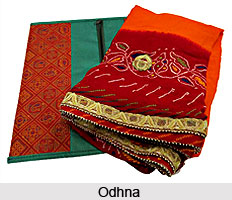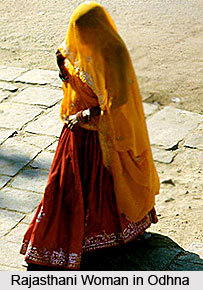The odhna is also called as odhni. It is a veil that represents the continuation of an unbroken tradition of wearing unstitched lengths of fabric that was the favored style of clothing during ancient India.
 The Vedic literature identifies the use of the stole as a universally worn over-garment called the uttariya that is a length of fabric draping the top half of the body. Early Sanskrit literature has a wide vocabulary of terms for the veil or stole, such as avagunthana, mukhapata, nimngika, sirovas-tra, nirivigi, and yavanika.
The Vedic literature identifies the use of the stole as a universally worn over-garment called the uttariya that is a length of fabric draping the top half of the body. Early Sanskrit literature has a wide vocabulary of terms for the veil or stole, such as avagunthana, mukhapata, nimngika, sirovas-tra, nirivigi, and yavanika.
The odhna, like other graceful attire, comes into its real beauty only when it is worn. It is a rectangular cloth, 3-4 meters in length and 1.25-2 meters wide. The odhna makes an notion, not just because of the beauty of its fabric and ornamentation, but also due to the grace of it`s draping. The fabric used may vary from fine voile to coarse cotton cloth, although georgette, fine silk and chiffon arc also used. Of late polyester has gained popularity because of its affordability, sturdiness and easy availability.
The odhna is embellished by many methods of ornamentation. These designs are usually dictated by tradition. Nevertheless, each woman contends with the other to wear a more beautiful odhna in Rajasthan. Some of the practices used to bring these exquisite odhna to life include bandhani, block printing, weaving and embroidery. The bandhani technique of Rajasthan produces all sorts of stunning and colourful odhna. Numerous leheriya styles abound, some of them being pralapsfwhi, rajashahi, gandadar, samudralehar and bhopalshahi. Block prints of Rajasthan also decorate the odhni-bhindi bhat, lalar, morya, karna and jaaj bhat are some common patterns. A striking odhna, known as phavri or phamri, is made of fine red voile, using a modified technique of block printing called tinsel printing. Gold or silver flowers are printed all over the fabric that are outstanding in relief. Brides wear a phavri as part of their wedding dress.
The most common form of surface ornamentation is the use of gota work on odhna. Woven bands of gold and silver produce dazzling floral and geometrical patterns. These designs arc distributed mostly around the head and the end pieces. All communities use this form of embroidery. Other styles of embroidery such as mukke-ka-kaam, kharak, suf, pakko bharat, kaccho bharat and khambhiri are also used to ornate the odhna. Certain weaves create exquisite designs on the surface of the odhna. Among Rajput, Osval and some other communities, the brocade technique is used to weave odhna, with silk threads in gorgeous colours, like bright pink and violet. The beauty of the odhna lies in the variety of its patterns of draping. In one such style, Rajasthani women pleat and tuck one end of the odhni into the left side of the ghaghra. The other end is carried under and behind the left arm, over the head from the back, onto the right shoulder, and tucked back into the ghaghra on the front left, covering the chest.

Another way is to make two to three pleats at one end, which are tucked into the left side of the ghaghra. The odhna covers the head and one end goes over the right shoulder. The other end goes under the arm, over the front of the body and tucks into the left side of the ghaghra`s waistband. Rajput women draw the odhni over the head and down, towards the chin to veil their face. In some regions of Rajasthan, they also drape a thirma, made of white fabric and large enough to cover the entire body.
Among the odhna, the chunri is the most frequently used. This is a tie-dyed odhni for the married woman of Rajasthan and its loveliness is often extolled in folk songs and stories. It is usually red, with designs like birds, flowers and leaves that are set in white. Another kind of odhna is the pila. It has a yellow base, a red central motif and borders and is symbolic of the arrival of a newborn in the family in Rajasthan. The lotus flower, a symbol of purity and fertility, lends its name to an odhna called the pomcha, which is made in bandhej and is a combination of red and yellow or red and pink. The borders and central flower are bright red on a ground of pink or yellow.
The odhna holds an important place in Rajasthani culture. Each element of the odhna alters to blend with the corresponding changes in the age and status of a woman. The fabric of the odhna is also firmly interwoven with the lives of the people. Particular colours and patterns symbolise various milestones, from childbirth, adulthood and marriage to death. Brides wear odhni of specified colours on their wedding day. Once married, the patterns and colours of a woman`s odhni reflect her status. Different coloured odhni are worn on festive days such as Holi and Teej. For example, a phaguniya with its traditional white base, red borders and red central design is generally worn for Holi.
In Rajasthan, the odhna is believed to be the first visual manifestation of the presence of a woman and, through it, she strives to express her personality and social identity. Married Bishnoi women wear the kan-grechi and the damini odhna. Jat wives use a Kara palla odhna, and those of ihe Meghvai community wear an angulha-chhap odhna. On the other hand, Jat widows wear a khopra bhat odhna but those of most other communities of Rajasthan wear mankhi bhat, kali jaal bhat and morya bhat odhna. In some parts of Rajasthan, a single coloured odhni tells that girl has not yet reached puberty, a large bandhni circle on one corner of the odhni, thereafter states that she is married; and a single large circle in the centre, in bright red, tells that she now is a mother-and suddenly, the colour deepens, the circles become shadowy; she is a widow. These concepts of form, colour and ornament are an integral part of the heartbeat of oral thought and tradition
The odhna is considered as the symbol of a woman`s community, her social and marital status as also her sense of modesty in Rajasthan. Greatly celebrated in literature, art and music, the odhna remains as popular attire of Indian women and finds place even in the expressions of popular culture of contemporary times.





















